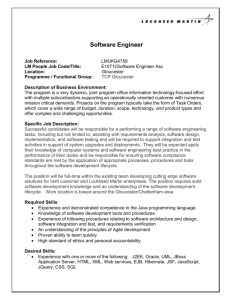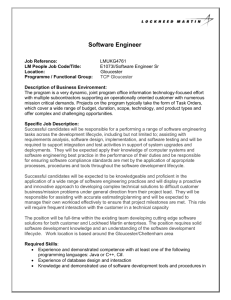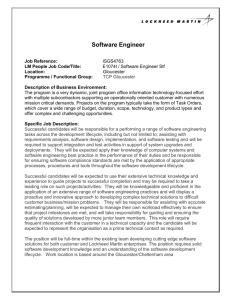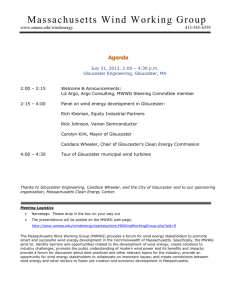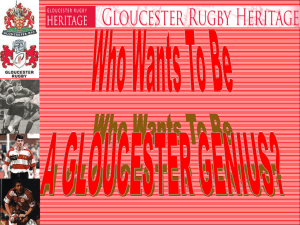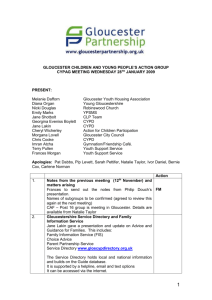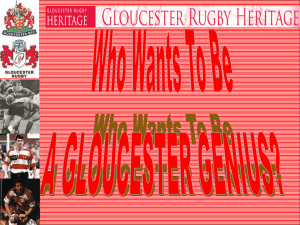1976
advertisement
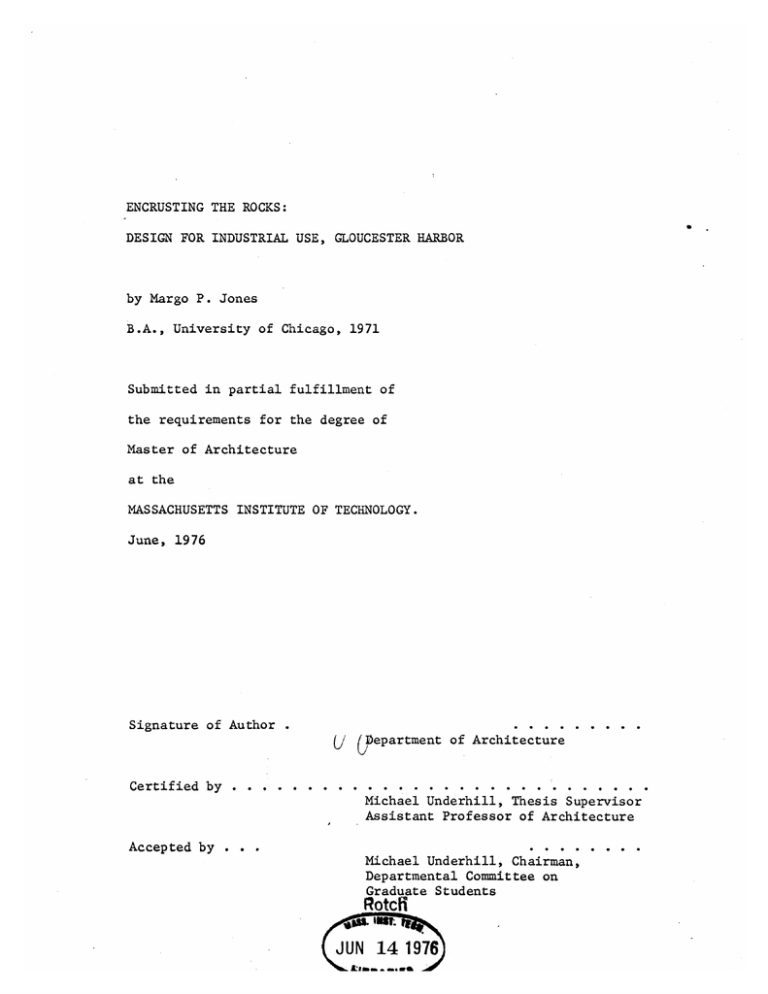
ENCRUSTING THE ROCKS:
DESIGN FOR INDUSTRIAL USE,
by Margo P.
GLOUCESTER HARBOR
Jones
B.A., University of Chicago, 1971
Submitted in
partial fulfillment of
the requirements for the degree of
Master of Architecture
at the
MASSACHUSETTS INSTITUTE OF TECHNOLOGY.
June, 1976
Signature of Author
.
UJ
.
.
.
.
.
.
.
.
(nepartment of Architecture
Certified by......
Michael Underhill, Thesis Supervisor
Assistant Professor of Architecture
Accepted by
.
.
Michael Underhill, Chairman,
Departmental Committee on
Graduate Students
Rotch'
JUN 14 1976
NAsfatse
I
ABSTRACT
ENCRUSTING THE ROCKS:
DESIGN FOR INDUSTRIAL USE,
by Margo P.
GLOUCESTER HARBOR
Jones
Submitted to the Department of Architecture on May 13, 1976
in partial fulfillment of the requirements for the
degree of Master of Architecture.
This thesis project presents the architectural design
of a built framework for a workplace located in
Gloucester Harbor, Massachusetts. A general discussion
is included of the economic and social issues involved
in workplace design, with emphasis on the Gloucester
case study as it fits into this theoretical context.
Aspects of the design process are described, including
network design, the repetition of "pieces" of ground
form, and the generation of the linear steel framework.
Drawings and photographs of a model document the final
design.
Thesis Supervisor:
Michael Underhill
Assistant Professor of Architecture
Eyes,
& polis,
fishermen,
& poets
or in every human head I've known is
busy
both:
the attention,
the care
and
however much each of us
chooses our own
kin and
concentration
2
And the few--that goes, even inside the major
economics. It is not true that the many,
even in fishing, say, Gloucester,
are the gauge
(where Ferrini, as so many,
go wrong
so few
have the polis
in their eye
The brilliant Portuguese owners,
They pour the money back
they do.
into engines, into their ships,
whole families do, put it back
They are but extensions of their own careers
in.
as mastheadsmen--as Burkes
Charles Olson
Letter 6.
3
TABLE OF CONTENTS
4
List of Figures
Introduction
I.
II.
Economic and Social Issues:
A Theoretical Framework
A.
Structures for People
10
B.
Tools for a Human Workplace
12-
The Community Fish Pier:
A Case Study in Workplace Design
f3
III. Design Methodology
Planning Assumptions
A.
Sit& and Community:
B.
Activities of the Workplace:
C.
Aspects of the Design Process:
Programatic Diagrams
16
Z
Networks
Formal References
27
The Built Ground
?,
The Framework
4-
IV.
Documentation:
V.
Bibliography.
Model and Drawings.
31
43
I1
PAGE
LIST OF FIGURES
17
1.
Gloucester, Massachusetts (U.S.G.S., 1960).
2.
Gloucester Harbor and-Annisquam River (U.S.D.C.,1975)
3.
Gloucester, 1831
4.
Second Waterfront Project (Gloucester, URBAN RENEWAL
PLAN, 1971 )
20
5.
Aerial Photograph, Gloucester Harbor and State Fish Pier
21
6.
Aerial Photograph, Waterfront II site
22_.
7.
"The fishery harbour: chain of activities"
FISHING PORTS AND MARKETS, p. 41)
18
(Courtesy Gloucester City Hall)
(F.A.O.,
27
26
8.
Distribution diagram
9.
Encrusted rock, Vancouver, British Columbia
28
10. Alvar Aalto, Malm, Main plan with funeral chapels,
(Fleig, ALVAR AALTO, p. 162)
37
11. Les Halle6 Centrales, Paris: Section
33
(Hennig-Schefold, TRANSPARENZ UND MASSE, p. 149)
12. Japanese domestic form: Gokonosho
(Kenchiku-Bunka, No. 9/1969)
33
13. Photograph
of Model, Overhead view
34
14. Photograph
of Model, Harbor view
35
15. Photograph
of Model, Closeup of Auction.
36
16. Drawing 1: Site Plan and Growth Projections
3~/
17. Drawing 2: Plan at +6 Feet
-3Z
18. Drawing 3: Plan at +20 Feet
39
19. Drawing 4: Section A-A,
through Auction
20. Drawing 5: Section B-B, through Fish Processing
21. Drawing 6: Section C-C,
longitudinal
22. Drawing 7: Details, Steel Framework.
40
47
INTRODUCTION
The design of a built framework for the Gloucester Community
Fish Pier, as shown in
of this thesis.
drawings and model form,
is
the end product
if it has been well
The physical framework,
designed, will be immediately useful, given present-time activities,
without the dimensions of past or future.
However, I am including
some general discussions of a number of related issues in
an effort
to clarity the process of creating that physical structure and to
allude to some of the specific well-tested references from which I
drew.
It is important to establish that a guiding motivation in
this project is
an interest in working on a use-form which seems
very worthy of attention but has not been traditionally considered
by architects.
People spend one third to one half of their lives at
work yet little conscious thought/attention/care is given to this
environment.
I also saw a number of formal reasons for considering the work
environment an untapped but fertile territory.
The vernacular
tradition--from barns to grain silos to stone crushers--is rich with
forms which are landmarks in
the built landscape.
The functional
demand of work architecture allows it a sculptural quality which is
to my mind rarely if
use forms.
Moreover,
ever justified in
purely residentially-generated
assuming that a prerequisite of good archi-
tecture is its ability to be useful, then the stringently functional
requirements of a working/production process are a good lesson in
6
creating responsive physical form.
The architecture of the workplace embodies the cultural values
of a given society in a particularly transparent manner.
In other
societies/civilizations where life-giving activities are not as
alienated, the differences in the built landscape between workplace
and home are not abrupt and both use-forms are in direct and positive
association with nature.
In examining modern Western cultures, we
need to look at specific "monuments" for statements of operating
culture values.
A current example of positive explorations of work-
place architecture is Hertzberger's office building in Apeldoorn
which he said he hoped would "contribute to the reconciliation of
work and house, of public and private, of building and street".1
On the other hand, Romaldo Guirguolo has recently designed prototypes
for the Olivetti Company which are meant to be "read" as an imageable consumer package which can be plugged into any site, the flatter
the better.
In an effort to establish the broader context for the architecture of this thesis, I have included three discussions on
1) economic and social issues, 2) the specific case study of a
community workplace, and 3) the planning and design process.
1 Herman
Hertzberber, in Architecture Pl,
Sept./Oct.,
1974
I.
ECONOMIC & SOCIAL ISSUES:
The Theoretical Framework.
The process of designing a workplace involves substantive issues
of political organization and social structure,
questions of energy use and technology.
and also raises
It is as important to be
aware of the values with which the architect designs as it
stand how to use the tee square and triangle.
is
to under-
Good values do not
necessarily make good design, but they are a prerequisite.
Small Is
Beautiful, by E. F. Schummaker, and Labor and Monopoly Capital, by
Harry Breverman, are two references from which I will draw to establish
the theoretical context or value framework which supports the built
place.
A.
Structures for People
The way in which a society is organized to get its work done
profoundly influences the people who are involved.
thesis of Small Is Beautiful:
The principle
Economics As If People Mattered, is
that the science of economics has been given too much importance in
people's lives, and moreover, that in countries where economics and
advanced technologies are dominant, giantism is rampant.
Schummaker,
To
the social and economic order needs to be reorganized:
We need the freedom of lots and lots of small, autonomous
units, and at the same time, the orderliness of large scale,
possibly global, unity and coordination. When it comes to
action, we obviously need small units, because action is a
highly personalized affair, and one cannot be in touch with
more than a very limited number of persons at any one time.
But when it comes to the world of ideas, to principles or to
ethics, to the indivisibility of peace and also of ecology,
we need to recognize the unity of mankind and base our
actions upon this recognition....What I wish to emphasize
6
is the duality of the human requirement when it comes to
the question of size: there is no single answer. For
his (her) purposes man (people) needs many different structures, both small ones and large ones, some exclusive and
some comprehensive.2
What is necessary is a political/economic/social structure which
responds to human-scale requirements,
which implies that it
be built
up of small community groups which add together in ways that enable
them to benefit from large-scale transportation and communication.
Thus there needs to be the range of sizes from small to large,
depending on the activity, but based on the fact that people need
comprehensible groups to work within, and the fact that as humans
we're all dependent upon and must work within the bounds of nature.
If the economic order is to be responsive to people, another
important manner other than scale which is presently deficient is
its treatment of certain earmarked people, i.e.
women and minorities.
When discussing freedom and order, it is important to clarify that
the benefits are meant to be applied to all people.
Again,
the
working world expresses the dominant social order very clearly:
terms of average earnings, the range from high to low is:
black men, white women, black women.
in
white men,
Recently women have been enter-
3
ing the work force at a higher rate.
It is interesting to note that
this improvement in economic position can be corollated with the period
of political activism of the late 1960s which was organized according
to principals discussed by Schummaker.
Women got together in small
groups, and from those groups worked on breaking down sexism in
situations ranging from very immediate, e.g
conditions, e._. abortion rights.
2
housework, to national
One spokesperson of the movement
E. F. Schummaker, Small Is Beautiful.
H. Breverman, Labor and Monopoly Capital.
repeats Schummaker's call for living within the dual nature of things,
and speaks for the humanizing influence which the increased role of
women might bring:
...The either/or dichotomy is inherently, classically
patriarchal. It is that puerile insistence on compartmentalization (art vs. science, intelligence vs.
passion, etc.) that I abhor. We needn't settle for
such impoverished choices. Reason without emotion is
fascistic; emotion without reason is sentimental (and
therefore also fascistic). Science and art budded
from the same stem--the alchemist poets, the Wiccean
herbalists, the Minaon and Druidic astrologer--mystics
and mathematician-musicians. The integration of such
crafts was assumed we now know, in the early matriarchal
cultures, but the love of excellence, a devotion to
skill, a thirst for wisdom, and a sense of humor are
still great unifiers, capable of overcoming the 4urrent
binary pigeonholing of people, ideas, vocations.
In suggesting new social/political/or economic structures,
Schummaker's book does not get very specific.
What will be necessary
is the reestablishment of community or regionally-based organization/
structures/institutions.
The idea of "community" means a group of
people, bonded by common landscape, working within and benefitting
from that landscape.
It implies a degree of shared responsibility
to a group of people and a set of natural resources.
Even though the
fact that a group of people inhabit a given region means that they
share something, the existing economic structure inhibits identification with and committment to that specific landscape.
As fossil
tuel and energy in general become more limited, people will probably
return to a greater degree of dependency on the land.
In most European
countries this means a closer, more symbiotic relationship with the
landscape.
Small Is
4
According to a critique which shares the viewpoint of
Beautiful:
Robin Morgan, "Rights of Passage", Ms. Magazine, September, 1975
p. 100.
10
We have become so dependent on massive resource use
that most Americans cannot conceive of operating on
a smaller scale of consumption, although such
technologically-advanced countries as New Zealand,
Switzerland, Japan and France operate quite well or
about one third the energy per person that we use. 5
B.
Tools for a Human Environment
If it is assumed that people and nature take precedence,
the theory which deals with economics from the point of view of
people will be most useful.
It
is
my assumption that people are
very fundamentally affected by the way in which they maintain
themselves economically.
Labor and Monopoly Capital is
a
reference which shares this assumption, and attempts to describe
and analyse the role of the people who are workers in modern
American industry.
Given the capitalist structure of the economy of this
country, Breverman sees modern industry and work as a function
of the capitalists to expand their capital; since the profit
motive is given highest priority,
labor power has become a commodity. Its uses are no
longer organized according to the needs and desires
of those who sell it,
but rather according to the
needs of the purchasers, who are, primarily, employers
seeking to expand the value of their capital. And
it is the special and permanent interest of these
purchasers to cheapen this commodity. 6
Of immediate importance in assessing work processes and
their degree of alienation or meaningfulness is the relationship
of the worker to the tools of production.
In terms of the
5
"Sharing Smaller Pies", New Age Journal,
6
Breverman, op. cit., p. 82.
p.
34.
historical development of technology,
an evolution (occurred) which may be described as an
increase in human control over the action of tools.
The evolution of machinery represents an expansion
of human capacities, an increase of human control
over the environment through the ability to elicit
from instruments of production an increasing range
and exactitude of response. But it is in the nature
of machinery, and a corollary of technical development, that the control over the machine need no
This
immediate operator.
longer be vested in its
possibility is seized upon by the capitalist mode of
7
production and utilized to the fullest extent.
It is this loss of control and hence responsibility which creates
the meaninglessness
of so many jobs.
Thus,
any system then which
simply asserts increases in productivity at whatever the human
cost must be criticized.
It is Breverman's hypothesis that the
unlimited growth attitude is a function of a profit-seeking
structure.
Schummaker, on the other hand, asserts that it is
technology itself which pulls us behind its own insatiable
expansion:
Technology, although of course the product of man, tends
to develop by its own laws and principles, and these are
very different from human nature or living nature in
general. Nature always, so to speak, knows where and
when to stop.. .and tends to be self-balancing, self8
adjusting, self-cleansing. Not so with technology.
Breverman points out a key characteristic of technology.
He
quotes a study by Bright at Harvard Business School which shows
that when production is mechanized to an advanced extent, the
human skill requirements are diminished:
ZBreverman, op. cit.
8
Breverman, op. cit., P,
146
12"
Gontray E&fe# an .$///RaJulet.mv
"S~i//fem
5
IncrsICin
4
6
A utILtIaefrin"
9
1o 11
i.
Leyals of mechaniteion
f 4y4tormnafic 9p4 fiPM
1
f1 15 IC 17
At the business level, this implies that what seems bigger and
better technically should not necessarily be sought if
maintain any challenge and meaningfulness.
work is
to
On the larger scale,
Breverman asserts that the replacement of people by machines is
leading to an increase in the percentage of people in the service
sector of the economy, i.e. people who are not directly productive.
Without restating his lengthy analysis,
suffice it
to say that the
average pay for the service worker is going down, thus indicating
that machines do not always truly upgrade our standard of living;
more selectivity in their application is in order.
13
II.
THE GLOUCESTER FISH PIER:
A Case Study in Community Architecture
I have chosen as a case study of work environments a program
for a community fishery facility with public uses, to be sited on
the Gloucester inner harbor.
One operating assumption of this
thesis is that the economy will become more and more decentralized.
For this reason I have focussed on an industry which is primary,
and a city which is far enough away from Boston to have and need an
economic life of its own.
I have to some extent worked with actual clients: the Gloucester
Community Fish Pier, Inc., the Overall Economic Development Commission of Cape Ann, and a loose-knit group of environmentally-active
citizens*
The Community Fish Pier, Inc. is the non-profit governing
body of the State Fish Pier, now0 dedicated to supporting the fishing
industry, which means primarily providing docking berths for medium
and small fishing boat owners and the services of ice and fuel which
they need to operate their businesses.
facilities,
To expand the existing
the Fish Pier has collaborated with the Overall Economic
a federally-funded regional
Development Commission of Cape Ann,
agency, and submitted a proposal to the Commerce Department for
Economic Development Act funds.
The following space needs program
was taken from that proposal:
Cold (Freezer) Storage
Fish Processing
Coop Dealer
20,000 sq. ft.
"
5,000 "
5,000 "
Coop Supplier
5,000
"
Auction
Retail Market
2,500
2,000
"
"
"
"
f2,000 sq. ft.
2,000 "
"
2,500
"
2,500 "
2,500 "
Fish Restaurant
Mech
Flash Freezer
Plate Freezer
Ice Making
TOTAL
51,000 sq.
ft.
The proposed new buildings constitute a support facility for
the small and medium-sized boat owners of Gloucester and can be
considered a "structure for people", as described in the previous
discussion.
The boats are small businesses, owned and operated
by local residents, fishing on one to seven day trips in nearby
Currently, the "giantism" of the international economic
waters.
structure is
catching these small operators in
a "cost-price
squeeze" which is increasingly forcing them out of business, as
the frozen fish industry takes over the national market and bigger
boats deplete the fish supply.
It
seems quite likely that there is
room for a range of fish operations, from the mega-scale factory
boats and 2,000,000 cubic foot frozen fish storage facilities,
to
the small independent operator who sells his/her fresh fish to local
markets.
This fresh fish market has not been fully developed, and
will probably be enlarged when the local fish supply increases (due
to the passage of the 200-mile limit) and considerations of energy
and nutitional value foster a return to more regional resources.
The
formation of a fishers' cooperative and auction are exactly the type
of organizations which are formed from the bottom up; they develop
out of the need to improve the base price paid for the fish "crops"
9
and the need to procure gear and materials at lower cost. The
desirability of a Fisheries Cooperative has been well documented
9
Marcus, Henry S. et al., Using Cooperatives to Aid the New
England Fishing Industry, Cambridge; M.I.T. Sea Grant
Program, 1974.
.5
as it would achieve economies of scale while maintaining local and
individual autonomy.
When designing a specific workplace, the issue of technology
can be very difficult to deal with.
In regards to the local fishing
economy of Gloucester, the vessels, unloading mechanisms, processing
equipment, freezing mechanisms, warehousing systems, and transport
equipment are.all subject to gradations of advanced technology.
To
participate in decisions regarding which levels of technology would
be most appropriate and most human for each operation is beyond the
scope of this thesis, and it raises a question regarding the architects role in the design of the workplace.
Although I had serious
questions about the sizes and required warehousing efficiencies, for
the sake of getting on to the physical form I accepted what seemed
to be a reasonable program in this regard.
However, it is worth
noting that certain aspects of the business remain a craft, such as
the skill
of filetting fish, as filletting
machinery requires too
high a level of productivity for the local processors.
For this
reason, the fish and the people remain in close proximity, and it
becomes a question of providing an efficient environment for dealing
with the fish, creating places for people wherever possible within
that working environment, and keeping the harbor and its activities
accessible to the community at large.
I.,
III.
DESIGN METHODOLOGY
A.
Site & Community:
Planning Assumptions
Gloucester is a city of 28,000 located on Cape Ann,
approximately one hour north of Boston.
The site of the
Gloucester Community Fish Pier is at the outer edge of the
downtown district of Gloucester, located at the end of
Route 128, a major transportation route for the Boston
F1GUM I-
region.
FI&ULE 3
filling between Five Pound Island and the mainland.
The Fish Pier was built with WPA funds by landAdja-
cent to the Fish Pier is a parcel of land assembled by
eminent domain by Urban Renewal, referred to as the Second
F11A/RE .4
Waterfront Project.
Formerly occupied by marginal opera-
tions of various sorts, the land has been cleared and
remains vacant until a final agreement is reached on the
reuse of the valuable territory currently zoned for industrial use.
One proposal accepted by the governing city
agency but disputed by environmental groups and others, has
been to fill
in
the inner bay and build a privately-owned
and operated cold storage facility, restaurant and parking
i&LJS-~
6
lot.
The dotted line on Figure 6 indicates the extent of
the proposed fill.
It was my assumption that planning for
the proposed expansion of the Community Fish Pier and the
development of the Urban Renewal land ought to be continuous
and reciprocal.
However, the political situation in Gloucester
is such that both parcels are run by city agencies which have
no recognized way of talking to each other.
37'30"
s Pi
,A
C-H
B A
S
T
U S E T
400"'-N.
V
Y
1244
4230"
42'30"
40'
66E.
SCALE1:24000
0U
A
10000-o 2000
00
H00
2000
H
1
200
3000
0D
4000
400
I
A ..
ROADCLASSIFICATION
sono
5
6000
60(10
7000FEET
Heavy-duty Medium-dUty
TER
IKLOM
CONTOURINTERVAL10 FEET
DATUM
IS MEANSEALEVEL
LOWWATER
IS MEAN
IN FEET-DATUM
CURVES
ANDSOUNDINGS
DEPTH
HIGH
W11ATfER
LINE
OFMEAN
THEAPPROXI"lATE
REPESNT
SHOWN
SHOREUINE
8.6FEET
RANGE
OFTIDE APPRXIMATELY
THE
MEAN
r
MASS
Light-duty
Unimproved
dirt
(
StateRoute
IS
QUADRANGLE
LOCATION
STANDARDS
MAPACCURACY
WITH
NATIONAL
THISMAPCOMPLIES
SURVEY,
WASHINGTON
25,D. C.
FORSALEBY U.S. GEOLOGICAL
ON REQUEST
IS AVAILABLE
ANDSYMBOLS
MAPS
TOPOGRAPHIC
DESCRIBING
A FOLDER
PI&UP-
I
GLOUCESTER, MASS.
N4233.75-W7037.5/8x7.5
1960
42*334V"*
70e37'30"
CAUTION
Only marine radiobeaconshave beencalibrated for
surface use. Limitations on the use of certain other
radio signals as aids to marine navigation can be
found ir the U.S. Coast Guard Light Usts and
Defense Mapping Agency Hydrographic Center
Publication H.O. 117 (A&B).
Radio direction-finder bearings to commercial
broadcastingstations are subject to error and should
be used with caution.
Station positions are shown thus:
O(Accurate location)
16
17
20
12
t7
24
WESTERN
25
2
23
OM
TARBOR
22 RA~
19
Babh
27
29
24
24
28
29
0
29
28
0
29
28
29 Rkb9
28
28
27
30
sfr
29
29
M3
0
28
24
19
29
28
28
27/
28
217'*/
23 /
117
28
29
/28
29
17
2
27
28
29
29
28
24
/
SOUTHEAST
29
30
30
30
31
28
21
9
29
19
011
27
30
30
27
26
28
31
30
27
/30
30
30
31
30
S TER
31
S
31
a\UNq
29
30
27
/
)
30
25
26
29
0
31
/
29
30
31
31-'
30
10
239/
28
25
o(Approximate location)
ART
'7 ~
i.
p,,rl
-4
FR0 M
AC
LAL
A RFr&
rK
dB3N
isa
-I y
w
*
IS
I
L
1
15
X vn
A-
J
A
qe
*Ij-
/4-
hans
V
cI
(iireer~4
Oiwse~te~ a1g~&,~y
.A*
Cl
JJU
C
F16UO
BOA..
~aice.
.w~wra'ea- J2,Z~M.
I
~
t
~
-,
POiNT OF COMENCEvEN'T OF BOUNDARY DESCRIPTION
REAL PROPERTY TO E A:OL"cED
FOR PUBLIC FAC!LIT !S
REAL PROPERTY TO BEAOURED,
FOR CLEARANCE A' RE-EVELPMENT
NOT TO BE ACO,=EzPRO:ERTY
PROJECT BCUNZAR!
AuI. m
ic
Et to
E
a:OBE : Lit
''.S,E
.
M'4 CT TOBE CLIAMCO
4a.: #
wt., SE liIJCT TORE%92
.'
.~
PROJECT BOUNDARY &
LAND ACQUISITION MAP
64--
- ;C'7UA :I
SECOND
t 10s.213
WATERFRONT
GLOUCESTER
.C LOUCE ST ER
1
PROJECT
AUTHORITY
HOUSING
MA SSACHUSETTS
2.7
~vur~ 5
tl&U)" 6
The harbor today, via private corporations and earlier
F1GL)AE
5
Urban Renewal efforts, is being filled and straightened for
faster, more efficient operations.
Finger piers are giving
way to runway-like docks and the total amount of harbor edge
and definition is diminishing.
eo
Very large cold storage
facilities have been built on the abrupt edge, effectively
walling off the harbor from the main street of the city.
It
has been my assumption from the start that these important
and useful forms could be built in such a way as to add to,
rather than prohibit, association with the activities at the
water's edge.
This project assumes the position that the Gloucester
Community Fish Pier Inc., as a public-minded agency, ought to
be granted an adjacent portion of the Waterfront II site.
This would eliminate the possibility of constructing redundant
facilities and would guarantee that such facilities would be
operated for the benefit of the greatest number of fishing
operations.
Also, rather than giving up more of the harbor
edge, the polluted water could be cleaned up, a job which
would be facilitated by the reopening of a stream which used
'3
to connect to Good Harbor beach.
B.
Activities of the Workplace:
Programmatic Diagrams
Designing a workplace involves understanding the work
process which is to take place within the stated space requirements.
The fishing industry is complex:
new methods are
continually being developed, yet the basic activity remains
an ancient and fundamental livelihood.
The richness of the
harbor edge is generated from the network shown in Figure 7.
A number of first hand visits to fishing facilities in
Gloucester, Boston, New Bedford and Martha's Vineyard
afforded the following understanding of the work process
involved in getting the fish from the harbor to the market:
CATCH4
OrrIC'es
VN -.OA1
CTTF
WfR.~N
WI.CJ4S
*O
-af1
3.
IN
CAKJNSv
-vCOLP
C.
Aspects of the Design Process:
Networks.
At the community or urban design scale it was necessary
to establish a network--how the goods and the people get in
and out--which can transcend time and use (e.g. the streets of
Back Bay).
This is the public, very active region which is
not necessarily built.
In residential architecture, this part
of the design process simply involves understanding present
some
and projecting future car and pedestrian traffic, with
consideration of service networks.
These projections imply
a diagram of the range from public to private places.
However
in an industrial workplace design, the service region is
dominant, and in this case rather complicated due to the range
--- - - - -, ---
I
--------------
f-5
HARBOUR AND FISHERY
AUTHORITIES ACTIVITIES
ACTIVITY
ASSOCIATED
OPERATIONS
CONTROL OF OPERATIONS
VESSELS
ADMINISTRATION
TRAFFIC
AND SHORE
BASE
CONTROL
SANITARY
SUPERVISION ALL
HARBOUR OPERATIONS
KEY:
MAINTENANCE
MAINTENANCE AND
REPAIR ALL HARBOUR
AUTHY. STRUCTURES
AUCTION
OR OTHER BULK
SALES
SUPERVISION OR
DIRECT CONTROL
INDUSTRIAL AND
OTHER PROPERTY
CONTROL OF LETTING,
SALES AND ACQUISITIONS
TAXES/
DUTIES
ACTIVITY
NEW
ASSOCIATED
OPERATIONS
EvLO5mrNT
~~1~
COLLECTION
ALL DUES
CONTROL OF INDUSTRIAL
GROWTH IN HARBOUR AREA
AND RFCOMMENDATIONS
FON NEW WOHKS
01"
<ZLIIJ r
27
of vehicles--boats, automobiles (workers and public), forklift trucks and tractor trailors--which are used.
One
important organizing theme which emerged was the idea that
the goods could be kept on and in the ground, and the people,
both the workers and the public, associated with a second
Figure 8 shows the 100th
level at approximately +14 feet.
scale distribution network, which incorporates the planning
assumptions described earlier.
Of note is the green areas
which would guarantee the visual access of the harbor to the
community.
Formal References.
A second order of the design process was to research
visual images of forms and places appropriate to the design
project.
This step involved putting together a collection
of visual references from natural forms, existing industrial
forms, vernacular harbor architecture with comparable geography,
and workplace architecture by architects whose work is
exemplary.
A few of those references most important from the
beginning were:
the universal harbor encrustation of large,
dense forms (rocks, piers) by (starfish, lichen, mussels)
P&
lighter forms; the harbor edges in
cities like Dubrovnik and
Amsterdam where industrial and public uses are mixed and
compatible, and the heavy walled forms become very habitable;
Aalto's Sawmill at Sunila; and Hertzberger's Linmij Laundry
in Amsterdam.
The use of formal references is, of course,
continuous throughout the design process.
218
23
The Built Ground.
A vocabulary of built form was established
by choosing an appropriate structural and building system, and then working with the families of
form chosen, in this case primarily ground form
M.ECHANC
PIo
LE
with a steel framework.
The industrial scale
definitely influenced these considerations.
A
PAOGT
AM "PNEoG"
AT s9WICZ/SToI.A&r
V j
concrete bay which was fairly wide was selected
to work together with a heavy, well-insulated
concrete wall.
In this design problem, the ware-
housing function lent itself to be treated as a
piece, or a rock: the processing and other activities would encrust onto these heavy forms and
the horizontal surface could be used for parking.
ThE BVW-T
FPToTOFpE (T
T
The repeatable piece was then arranged on the
landscape as in Figure 8.
The actual physical
definition of the piece was established at 40th
scale, making modifications according to local
ArTOMo-e
AoID
conditions in the network and the need to estabHA lTAbLE
lish the "rocks" at different levels.
"AIEC
AT PAKN &/PEDESTI
L Va
U
Also at
work here was the use of Aalto as a reference,
X4 10 specifically his chapel design at Malm.
The Framework.
The design of the steel framework brought to
focus the human requirements and hence became
primarily a 20th scale decision problem.
At this
30
FL&ULE 11
point the references used were les Halles in Paris, chosen
for its changeable, large-scale quality which seemed especially suitable for the auction-place.
The form of the second-
ary reference level above the working level seemed to be akin
to the pedestrian distribution in traditional domestic Japanf I , 1 I'E 12.
ese architecture, with also an obvious reference to other seaside boardwalks.
The framework itself, with its linear nature
and directional bay, was the nost powerful form generator when
dealt with directly in model form.
The design of the closure
of the framework is most well defined by the "5e of the metal
roofing.
The degree of closure, ranging from simply covered
sheds to very finished offices, would be generated by the
specific inhabitants.
Drawing 4 suggests such closure, con-
sisting of unit masonry, metal casement and fixed sash, glass
block,
and exterior panels.
t4
~T
Y\A
I',
IiG UP2- 10
Hauptplan I f500 mit Abdankungskapololn I Le plan avec to* chapetlos I Main plan with funeral chapels
A.
Abb. 47-49), Schnitt durch
Les Halles Centrales, Paris 1851-59, Architekten: V. Baltard und F. E. Callet (zu
einen Pavillon und Verbindungsstrae M. 1: 200 (Quelle: Baltard, Monographie des Halles Centrales)
-
--
m
kiR
I
IFl6ukE
-
rrn-----
-+-
-
Pf6U IZF
I?-
OZ.:ij 4v 134OW
1N19NO
Pi
4--AAQIA
A.
-. 4
/
I
'"H'
I
i
35
71-
I
9!
I;
L/
It
di
A
04
yr
r
mI7f-=1
31
/
DESIGN FOR
INDUSTRIAL
USE,
~V\j*~<
IL..
GLOUCESTER
/1
HARBOR
)
'
(
~
I
,~.:
*. :2.
.. ~
~-0
J.
~
~-~--
/
~i
-
-
i~fl4..:
t:1-. 1
w~
*
.~-
. . .
~-
N
-~
SITE
PLAN
&GROWTH
PROJECTION
us
38
b
A*
MA-*
cisse
VOW,
j{---
--.
N
PLANE
-
A
t
iU
1'ibtf-! 17
~
-
-
~rw
at*6
39
/7.
/
4
1
~AK7
ji---,
rr
\\
pis"
\
~~Ott
L
-7
1Ar
~~PL
too.1t7
Eli
2
(L
AN
+
r-JO
M-
TO
FEET
D
~
'A
4
~'.
~.
.~
-
-
4/it ~lrO4t
TiI
41
5;
4"M
.mWS
4"bio
w1
-
Sod0~
I)'
STIE
p-op
4
4'AOT3 LR VM
f
II
p
I "
?I!r.apr_ IIMP
. le F
.
w
,
. P.
. "
.
-
TI-.-,'
CT.4
LU
OL
:2
BIBLIOGRAPHY
Adie, Donald W. MARINAS: A WORKING GUIDE TO THEIR DEVELOPMENT AND
DESIGN. London: The Architectural Press, 1975.
LABOR AND MONOPOLY CAPITAL.
Breverman, Harry.
Review Press, 1974.
DeCarlo,
GianCarlo..
URBINO.
Padova,
Marsilio,
New York:
Monthly
1966.
PHASE ONE REPORT,
Downtown Development Commission.
GLOUCESTER. Gloucester, September, 1975.
CITY OF
Edwards and Kelcey, Consultants to Gloucester Planning Board.
GENERAL PLAN REPORT, Volumes I and II.
GLOUCESTER:
Gloucester, 1963.
Fleig, Karl.
ALVAR AALTO.
New York:
Wittenborn & Co.,, 1963.
Food and Agriculture Organization of the United Nations. FISHING
Fishing News (Books) Ltd., 1970.
PORTS AND MARKETS. London:
Fisheries Reports, No. 13.
COOPERATIVES. Rome, 1971.
________,
_______,
MANUAL ON FISHERMEN'S
Fisheries Reports, No. 36. LANDING AND MARKETING
FACILITIES AT SELECTED SEA FISHING PORTS. Rome, 1966.
Gloucester Housing Authority, H.U.D. Report R-128. DRAFT ENVIRONMENTAL IMPACT STATEMENT, SECOND WATERFRONT URBAN RENEWAL
PROJECT. Gloucester, August, 1975.
RENEWAL PLAN: SECOND WATERFRONT PROJECT,
GLOUCESTER, MASS. Gloucester, June 1971.
________,URBAN
Gloucester Community Pier Association, Inc. E.D.A.. TITLE IX
GRANT APPLICATION TO OVERALL ECONOMIC DEVELOPMENT COMM2ISSION
"Gloucester State Fish Pier Modular Development
OF CAPE ANN:
Program." Gloucester, May, 1975.
INNER
Gloucester Housing Authority, by Candeub, Fleissig & Assoc.
1969.
January,
MASSACHUSETTS.
GLOUCESTER,
PLAN,
DISTRICT
HARBOR
Gloucester Planning Board, by Philip B. Herr and Associates.
GENERAL PLAN SUPPLEMENT, CITY OF GLOUCESTER,. MASSACHUSETTS.
Adopted as Policy, December, 1969.
Hennig-Schefold, Monica, & Helga Schmidt-Thomsen. TRANSPARENZ tIND
PASSAGEN UND HALLEN AUS ELSEN UND GLAS, 1806-1880.
MASSE:
Verlag M. DuMont Schauberg, 1972.
Koln;
Lynch, Kevin. SITE PLANNING, Second Edition.
Press, 1962.
Cambridge:
M.I.T.
Marcus, Henry S., et al. USING COOPERATIVES TO AID THE NEW ENGLAND
FISHING INDUSTRY. Cambridge: M.I.T. Sea Grant Program, 1974.
McPherson, Roy Nick, ed. GLOUCESTER RESOURCE STUDY. Interdepartmental Project in Systems Engineering at M.I.T. Spring term,
1973. Cambridge: M.I.T. Sea Grant, 1973.
Overall Economic Development Committee of Cape Ann, Inc. OVERALL
ECONOMIC DEVELOPMENT PLAN. Revised, April, 1975. Gloucester,
Mass.
Olson, Charles. SELECTED WRITINGS.
Books, 1966.
New York:
New Directions
Parsons, Peter and Peter Anastas. WHEN GLOUCESTER WAS GLOUCESTER:
TOWARD AN ORAL HISTORY OF THE CITY. Photographs by Mark
Power. Gloucester: Gloucester 350th Anniversary Celebration,
Inc., 1973.
Roisecco, Giulio. L'ARCHITETTURA DEL FERRO, LA ERANCIA (1715-1914).
Bulzoni editore, 1974.
Vol. II. Roma:
Richards, J.M. with photographs by Eric de Mare. THE FUNCTIONAL
TRADITION IN EARLY INDUSTRIAL BUILDINGS. Architectural Press:
London, 1958.
Schummaker, E.F. SMALL IS BEAUTIFUL:
New York:
Harper & Row, 1973.
ECONOMICS AS IF PEOPLE MATTERED.
Smith, Maurice. "What is 'Architecture'/Should 'Architecture' Be/
HARVARD EDUCATIONAL REVIEW,
Are Architects/Designers For?"
ARCHITECTURE AND EDUCATION, Vol. 39, #4, 1969, pp. 69-86.
It is undone business
I speak of, this morning,
with the sea
stretching out
from my feet
Charles Olson
MAXIMUS, TO HIMSELF
